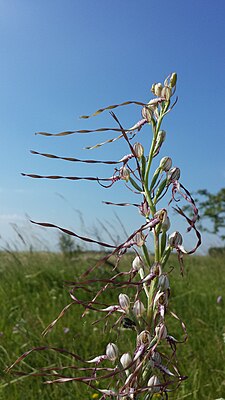Adria strap end
| Adria strap end | ||||||||||||
|---|---|---|---|---|---|---|---|---|---|---|---|---|

Adriatic strap tongue ( Himantoglossum adriaticum ) near Vienna |
||||||||||||
| Systematics | ||||||||||||
|
||||||||||||
| Scientific name | ||||||||||||
| Himantoglossum adriaticum | ||||||||||||
| H. Baumann |
The Adriatic belt tongue ( Himantoglossum adriaticum ), also Adriatic Riemenzunge called, is a plant type from the kind of tongue-pieces ( Himantoglossum ) in the family of orchids (Orchidaceae). This showy, stately species occurs in the warmer areas of Central Europe and in southern and southeastern Europe .
description
The Adria belt tongue is a perennial herbaceous plant that reaches heights of 50 to 70 cm. The basal leaves, which are already missing at the time of flowering, are 10 to 12 cm long and 4 to 5 cm wide, the leaves are elongated to lanceolate.
The flowering period extends from late May to June. The inflorescence contains around 25 to 40 flowers. The slightly pleasantly sweet-smelling flowers are hermaphrodite and zygomorphic . The calyx and paired petals that make up the helmet are glued together and veined with whitish pale pink or pale green on the outside and brown-red inside. The deep three-lobed lip is covered in the whitish part with brown-red tufts of hair and the 3.5 to 6 cm long and conspicuous middle lobe is slightly twisted or twisted and split 5 to 18 mm deep at the tip. In the bud, the middle lobe is twisted in like a clock spring for reasons of space during its development and only unrolls as soon as the flower opens. The spur measures 2 to 4 mm.
The number of chromosomes is 2n = 36 or 37.
ecology
The development process of the Adria belt tongue shows it as a (sub) Mediterranean floral element : after rainfalls in autumn, its growth phase begins with the planting of winter leaves and a new tuber as a result. The growth continues in the cold season, so individual leaves can often be lost due to frost damage. The next growth phase begins in early spring to fill the new tuber and allow the plant to bloom in May. In dry locations, the leaves die off before they bloom in order to limit water loss. The tuber survives the dry and hot summer until autumn and then starts the growth cycle all over again.
The pollination is done by bees kurzrüsselige, such as sand and colletes which tiny with their trunks cell sap droplets, which are excreted in the spur base, collect. Long-nosed honey bees search in vain for nectar in the spur and pollinate in the process. The spur and the imposing flower serve to attract and deceive the pollinators, the long central lobe is provided as an approach runway for the insects.
Occurrence and endangerment
The Adria belt end is found in Austria , Italy , the Czech Republic , Slovakia , Hungary , Slovenia , Croatia and via Serbia to Moldova .
In Austria, the Adriatic belt tongue rarely occurs in light (downy oak) forests, on the edges and semi-arid grasslands of the colline to submontane altitude . It is considered endangered. The occurrences are limited to the Pannonian area of the federal states of Burgenland , Vienna and Lower Austria , individual occurrences extend into the eastern flysch - Wienerwald .
Taxonomy
This species used to be known as the subspecies Himantoglossum hircinum subsp. adriaticum of the buck's strap tongue ( Himantoglossum hircinum ). In 1978, Helmut Baumann described the Adriatic strap tongue as a separate species based on the population in Istria. It differs from the Bocks strap tongue, which occurs further west, for example in Germany , France and England , in several features: among other things, its flowers smell pleasant instead of the smell spread by billy goats and the inflorescence is looser.
photos
Individual evidence
- ↑ Himantoglossum adraticum at Tropicos.org. In: IPCN Chromosome Reports . Missouri Botanical Garden, St. Louis
- ↑ Distribution map .
literature
- Manfred A. Fischer, Karl Oswald, Wolfgang Adler: Excursion flora for Austria, Liechtenstein and South Tyrol . 3rd, improved edition. State of Upper Austria, Biology Center of the Upper Austrian State Museums, Linz 2008, ISBN 978-3-85474-187-9 .
- Marion Werling: The Adria strap tongue. In: Heinz Wiesbauer, Herbert Zettel, Manfred A. Fischer, Rudolf Maier (eds.): The Bisamberg and the Old Schanzen, diversity on the edge of the city of Vienna. St. Pölten 2011, ISBN 3-901542-34-5 .
- Norbert Novak: Orchids (Orchidaceae). In: Heinz Wiesbauer, Herbert Zettel, Manfred A. Fischer, Rudolf Maier (eds.): The Bisamberg and the Old Schanzen, diversity on the edge of the city of Vienna. St. Pölten 2011, ISBN 3-901542-34-5 .
Web links
- Datasheet on the Adria strap tongue in botany in the picture (Contains information from Manfred A. Fischer, Karl Oswald, Wolfgang Adler: Excursion flora for Austria, Liechtenstein and South Tyrol . 3rd, improved edition. Province of Upper Austria, Biology Center of the Upper Austrian State Museums, Linz 2008, ISBN 978-3-85474-187-9 , pp. 633 . ).
- Himantoglossum adriaticum inthe IUCN Red List of Threatened Species 2013.1. Posted by: A. Dostalova, C. Montagnani, I. Hodálová, N. Jogan, G. Király, V. Ferakova, KG Bernhardt, 2011. Retrieved September 2, 2013.




